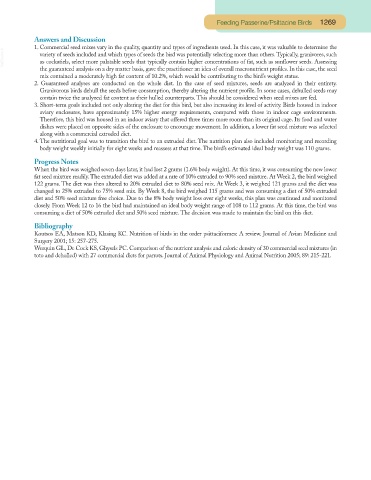Page 1219 - Small Animal Clinical Nutrition 5th Edition
P. 1219
Feeding Passerine/Psittacine Birds 1269
Answers and Discussion
1. Commercial seed mixes vary in the quality, quantity and types of ingredients used. In this case, it was valuable to determine the
VetBooks.ir variety of seeds included and which types of seeds the bird was potentially selecting more than others.Typically, granivores, such
as cockatiels, select more palatable seeds that typically contain higher concentrations of fat, such as sunflower seeds. Assessing
the guaranteed analysis on a dry matter basis, gave the practitioner an idea of overall macronutrient profiles. In this case, the seed
mix contained a moderately high fat content of 10.2%, which would be contributing to the bird’s weight status.
2. Guaranteed analyses are conducted on the whole diet. In the case of seed mixtures, seeds are analyzed in their entirety.
Granivorous birds dehull the seeds before consumption, thereby altering the nutrient profile. In some cases, dehulled seeds may
contain twice the analyzed fat content as their hulled counterparts. This should be considered when seed mixes are fed.
3. Short-term goals included not only altering the diet for this bird, but also increasing its level of activity. Birds housed in indoor
aviary enclosures, have approximately 15% higher energy requirements, compared with those in indoor cage environments.
Therefore, this bird was housed in an indoor aviary that offered three times more room than its original cage. Its food and water
dishes were placed on opposite sides of the enclosure to encourage movement. In addition, a lower fat seed mixture was selected
along with a commercial extruded diet.
4. The nutritional goal was to transition the bird to an extruded diet. The nutrition plan also included monitoring and recording
body weight weekly initially for eight weeks and reassess at that time. The bird’s estimated ideal body weight was 110 grams.
Progress Notes
When the bird was weighed seven days later, it had lost 2 grams (1.6% body weight). At this time, it was consuming the new lower
fat seed mixture readily. The extruded diet was added at a rate of 10% extruded to 90% seed mixture. At Week 2, the bird weighed
122 grams. The diet was then altered to 20% extruded diet to 80% seed mix. At Week 3, it weighed 121 grams and the diet was
changed to 25% extruded to 75% seed mix. By Week 8, the bird weighed 115 grams and was consuming a diet of 50% extruded
diet and 50% seed mixture free choice. Due to the 8% body weight loss over eight weeks, this plan was continued and monitored
closely. From Week 12 to 16 the bird had maintained an ideal body weight range of 108 to 112 grams. At this time, the bird was
consuming a diet of 50% extruded diet and 50% seed mixture. The decision was made to maintain the bird on this diet.
Bibliography
Koutsos EA, Matson KD, Klasing KC. Nutrition of birds in the order psittaciformes: A review. Journal of Avian Medicine and
Surgery 2001; 15: 257-275.
Werquin GL, De Cock KS, Ghysels PC. Comparison of the nutrient analysis and caloric density of 30 commercial seed mixtures (in
toto and dehulled) with 27 commercial diets for parrots. Journal of Animal Physiology and Animal Nutrition 2005; 89: 215-221.

